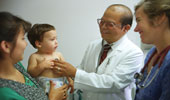Culture, Language and Health Literacy
Effective health communication is as important to health care as clinical skill. To improve individual health and build healthy communities, health care providers need to recognize and address the unique culture, language and health literacy of diverse consumers and communities.
Simply Put: A Guide for Creating Easy-to-Understand Materials (PDF - 1.9 MB) Centers for Disease Control and Prevention
Toolkit for Making Written Materials Clear and Effective Centers for Medicare and Medicaid Services
Clear Communication: An NIH Health Literacy Initiative National Institutes of Health
Plain Language.gov - Improving Communication from the Federal Government to the Public
National Partnership for Action to End Health Disparities Toolkit for Community Action (PDF - 9.4 MB) U.S. Department of Health and Human Services
10 Attributes of a Health Literate Organization Institute of Medicine ![]() (PDF - 102 KB) | Slide Presentation
(PDF - 102 KB) | Slide Presentation ![]()
Collecting Culturally- and Linguistically-Specific Patient Data. Under the Affordable Care Act, to the extent practicable, federal health data collections will include culturally- and linguistically-specific data on populations served. Guidance and tools have yet to be developed. This information is included as an advisory for program planners. Learn more: Title XXXI, Sec. 3101 of the Affordable Care Act (PDF - 2.2 MB)
Culture. Attitudes and behaviors that are characteristic of a group or community. Learn more: What is Cultural Competence? (Office of Minority Health)
Cultural Competence. A set of congruent behaviors, attitudes, and policies that come together in a system, agency, or among professionals that enables effective work in cross-cultural situations. What is Cultural Competence? (Office of Minority Health)
Linguistic Competence
The capacity to communicate effectively and convey information in a manner that is easily understood by diverse audiences. Linguistic Competence: Definition ![]() (National Center for Cultural Competence)
(National Center for Cultural Competence)
Health Literacy
The degree to which individuals have the capacity to obtain, process and understand basic health information and services needed to make appropriate health decisions. Healthy People 2010, Objective 11-2 (PDF - 13 MB)
Plain Language
Writing that is clear and to the point, which helps to improve communication and takes less time to read and understand. Clear Communication: An NIH Health Literacy Initiative (National Institutes of Health)








